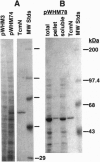Abstract
Aromatic polyketides are assembled by a type 11 (iterative) polyketide synthase (PKS) in bacteria. Understanding the enzymology of such enzymes should provide the information needed for the synthesis of novel polyketides through the genetic engineering of PKSs. Using a previously described cell-free system [B.S. & C.R.H. (1993) Science 262, 1535-1540], we studied a PKS enzyme whose substrate is not directly available and purified the TcmN polyketide cyclase from Streptomyces glaucescens. TcmN is a bifunctional protein that catalyzes the regiospecific cyclization of the Tcm PKS-bound linear decaketide to Tcm F2 and the 0-methylation of Tcm D3 to Tcm B3. In the absence of TcmN, the decaketide formed by the minimal PKS consisting of the TcmJKLM proteins undergoes spontaneous cyclization to form some Tcm F2 as well as SEK15 and many other aberrant shunt products. Addition of purified TcmN to a mixture of the other Tcm PKS components both restores and enhances Tcm F2 production. Interestingly, Tcm F2 but none of the aberrant products was bound tightly to the PKS. The results described support the notion that the polyketide cyclase, not the minimal PKS, dictates the regiospecificity for the cyclization of the linear polyketide intermediate. Furthermore, because the addition of TcmN to the TcmJKLM proteins results in a significant increase of the total yield of decaketide, interactions among the individual components of the Tcm PKS complex must give rise to the optimal PKS activity.
Full text
PDF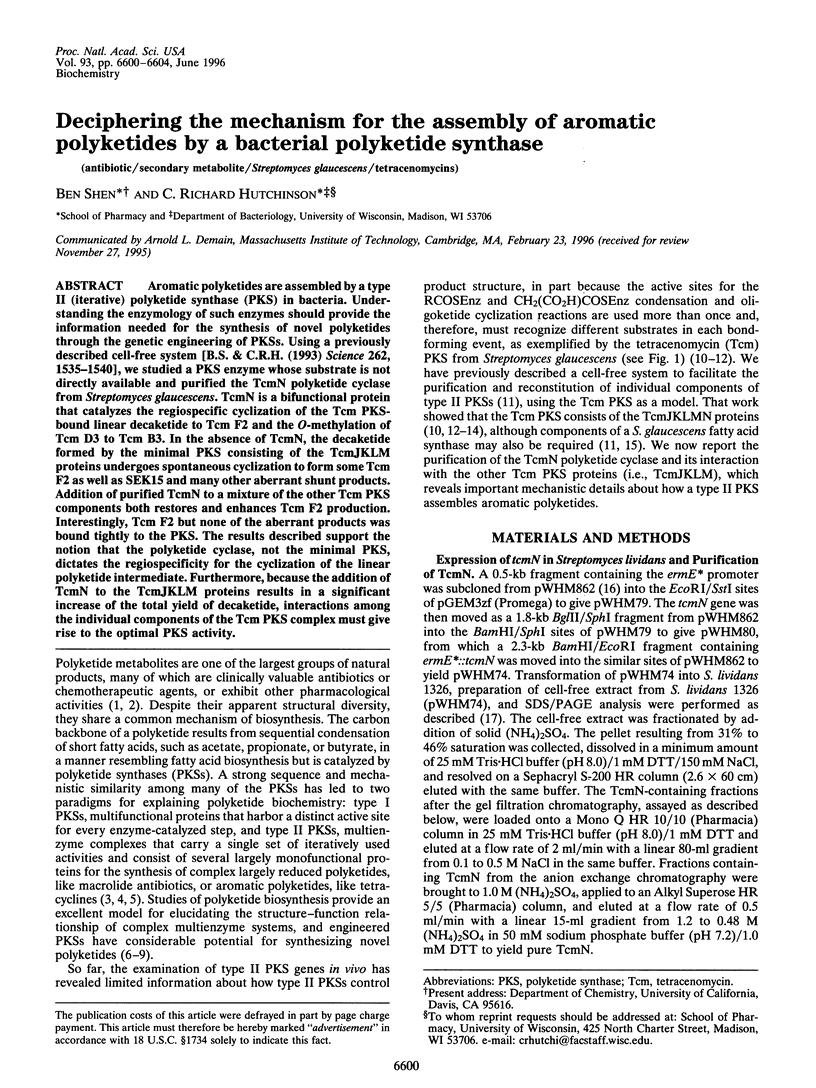
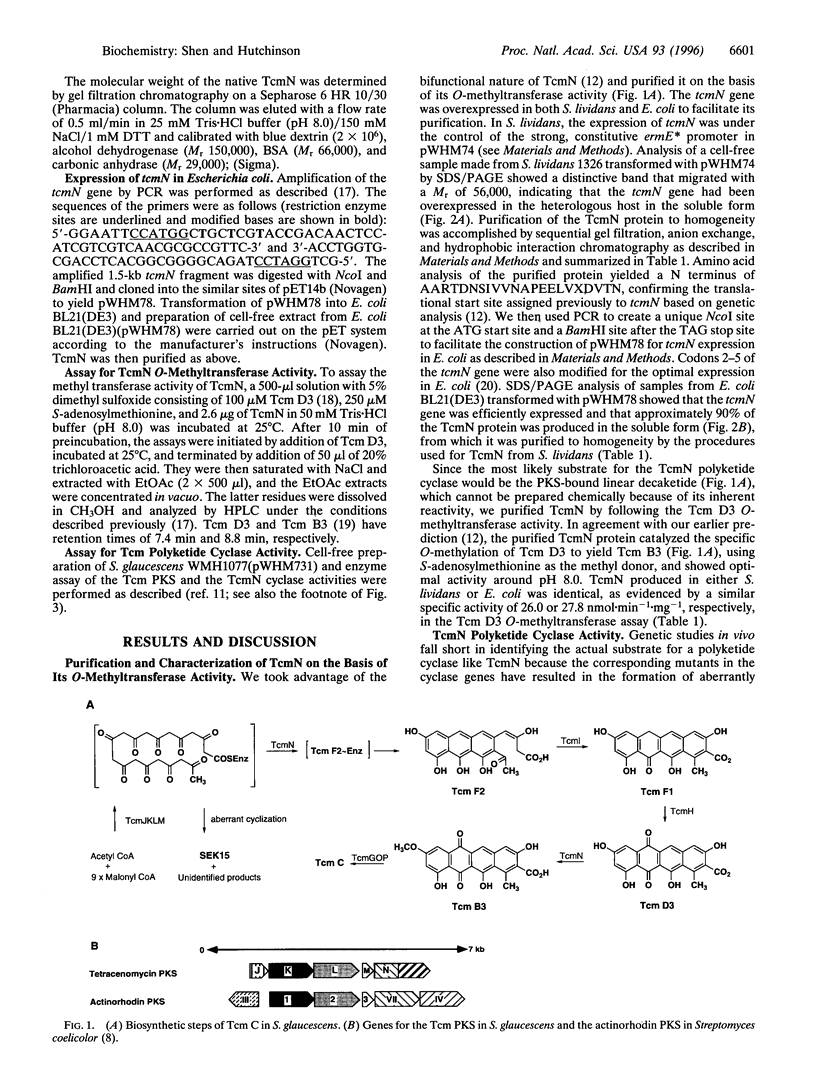
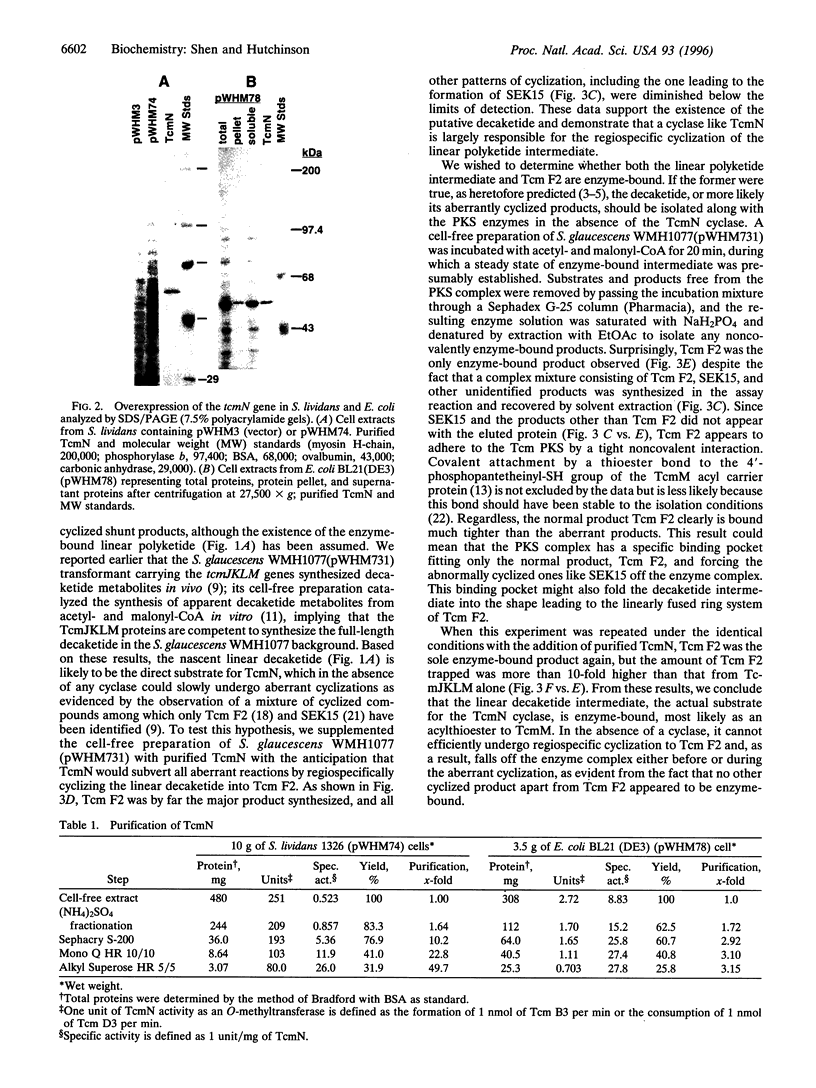
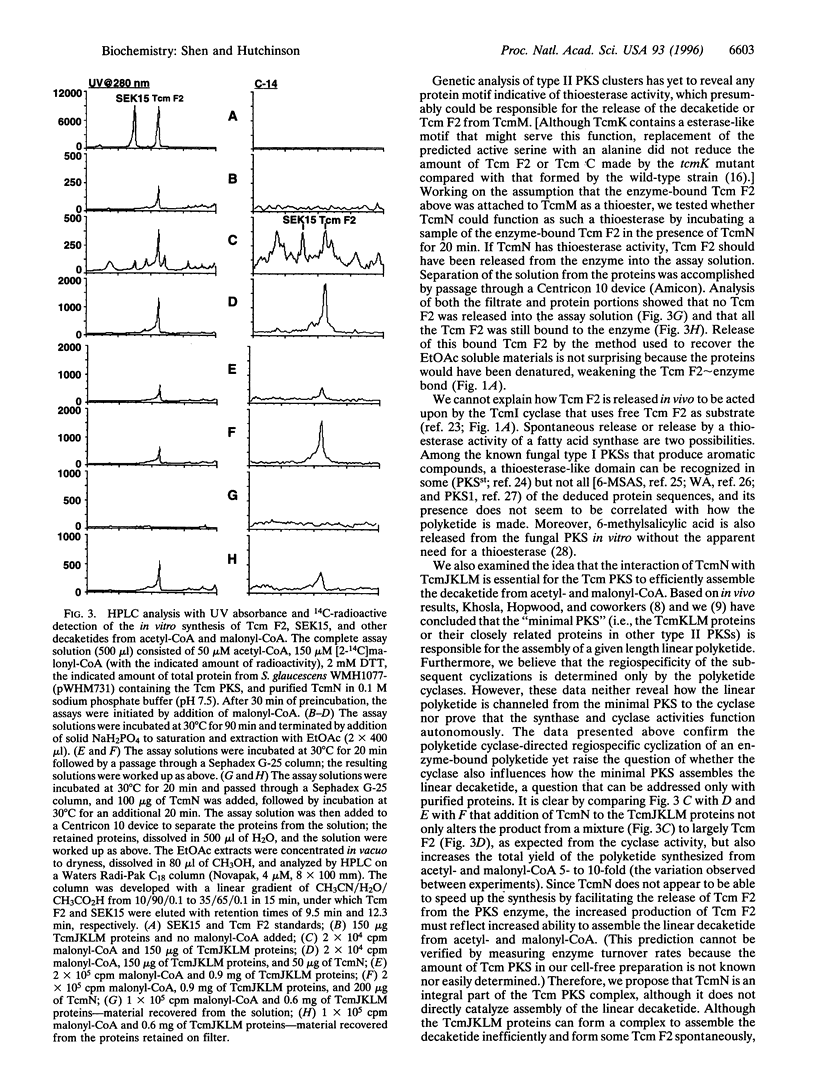
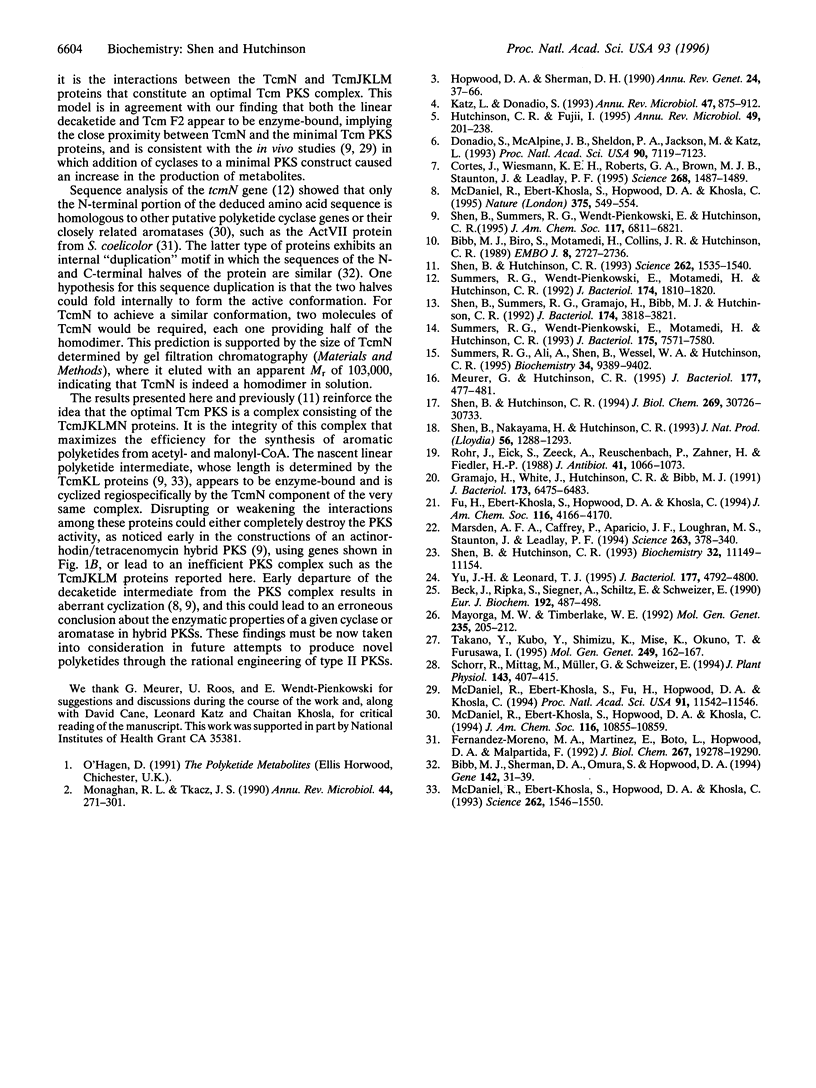
Images in this article
Selected References
These references are in PubMed. This may not be the complete list of references from this article.
- Beck J., Ripka S., Siegner A., Schiltz E., Schweizer E. The multifunctional 6-methylsalicylic acid synthase gene of Penicillium patulum. Its gene structure relative to that of other polyketide synthases. Eur J Biochem. 1990 Sep 11;192(2):487–498. doi: 10.1111/j.1432-1033.1990.tb19252.x. [DOI] [PubMed] [Google Scholar]
- Bibb M. J., Biró S., Motamedi H., Collins J. F., Hutchinson C. R. Analysis of the nucleotide sequence of the Streptomyces glaucescens tcmI genes provides key information about the enzymology of polyketide antibiotic biosynthesis. EMBO J. 1989 Sep;8(9):2727–2736. doi: 10.1002/j.1460-2075.1989.tb08414.x. [DOI] [PMC free article] [PubMed] [Google Scholar]
- Bibb M. J., Sherman D. H., Omura S., Hopwood D. A. Cloning, sequencing and deduced functions of a cluster of Streptomyces genes probably encoding biosynthesis of the polyketide antibiotic frenolicin. Gene. 1994 May 3;142(1):31–39. doi: 10.1016/0378-1119(94)90351-4. [DOI] [PubMed] [Google Scholar]
- Cortes J., Wiesmann K. E., Roberts G. A., Brown M. J., Staunton J., Leadlay P. F. Repositioning of a domain in a modular polyketide synthase to promote specific chain cleavage. Science. 1995 Jun 9;268(5216):1487–1489. doi: 10.1126/science.7770773. [DOI] [PubMed] [Google Scholar]
- Donadio S., McAlpine J. B., Sheldon P. J., Jackson M., Katz L. An erythromycin analog produced by reprogramming of polyketide synthesis. Proc Natl Acad Sci U S A. 1993 Aug 1;90(15):7119–7123. doi: 10.1073/pnas.90.15.7119. [DOI] [PMC free article] [PubMed] [Google Scholar]
- Fernández-Moreno M. A., Martínez E., Boto L., Hopwood D. A., Malpartida F. Nucleotide sequence and deduced functions of a set of cotranscribed genes of Streptomyces coelicolor A3(2) including the polyketide synthase for the antibiotic actinorhodin. J Biol Chem. 1992 Sep 25;267(27):19278–19290. [PubMed] [Google Scholar]
- Gramajo H. C., White J., Hutchinson C. R., Bibb M. J. Overproduction and localization of components of the polyketide synthase of Streptomyces glaucescens involved in the production of the antibiotic tetracenomycin C. J Bacteriol. 1991 Oct;173(20):6475–6483. doi: 10.1128/jb.173.20.6475-6483.1991. [DOI] [PMC free article] [PubMed] [Google Scholar]
- Hopwood D. A., Sherman D. H. Molecular genetics of polyketides and its comparison to fatty acid biosynthesis. Annu Rev Genet. 1990;24:37–66. doi: 10.1146/annurev.ge.24.120190.000345. [DOI] [PubMed] [Google Scholar]
- Hutchinson C. R., Fujii I. Polyketide synthase gene manipulation: a structure-function approach in engineering novel antibiotics. Annu Rev Microbiol. 1995;49:201–238. doi: 10.1146/annurev.mi.49.100195.001221. [DOI] [PubMed] [Google Scholar]
- Katz L., Donadio S. Polyketide synthesis: prospects for hybrid antibiotics. Annu Rev Microbiol. 1993;47:875–912. doi: 10.1146/annurev.mi.47.100193.004303. [DOI] [PubMed] [Google Scholar]
- Marsden A. F., Caffrey P., Aparicio J. F., Loughran M. S., Staunton J., Leadlay P. F. Stereospecific acyl transfers on the erythromycin-producing polyketide synthase. Science. 1994 Jan 21;263(5145):378–380. doi: 10.1126/science.8278811. [DOI] [PubMed] [Google Scholar]
- Mayorga M. E., Timberlake W. E. The developmentally regulated Aspergillus nidulans wA gene encodes a polypeptide homologous to polyketide and fatty acid synthases. Mol Gen Genet. 1992 Nov;235(2-3):205–212. doi: 10.1007/BF00279362. [DOI] [PubMed] [Google Scholar]
- McDaniel R., Ebert-Khosla S., Fu H., Hopwood D. A., Khosla C. Engineered biosynthesis of novel polyketides: influence of a downstream enzyme on the catalytic specificity of a minimal aromatic polyketide synthase. Proc Natl Acad Sci U S A. 1994 Nov 22;91(24):11542–11546. doi: 10.1073/pnas.91.24.11542. [DOI] [PMC free article] [PubMed] [Google Scholar]
- McDaniel R., Ebert-Khosla S., Hopwood D. A., Khosla C. Engineered biosynthesis of novel polyketides. Science. 1993 Dec 3;262(5139):1546–1550. doi: 10.1126/science.8248802. [DOI] [PubMed] [Google Scholar]
- McDaniel R., Ebert-Khosla S., Hopwood D. A., Khosla C. Rational design of aromatic polyketide natural products by recombinant assembly of enzymatic subunits. Nature. 1995 Jun 15;375(6532):549–554. doi: 10.1038/375549a0. [DOI] [PubMed] [Google Scholar]
- Meurer G., Hutchinson C. R. Functional analysis of putative beta-ketoacyl:acyl carrier protein synthase and acyltransferase active site motifs in a type II polyketide synthase of Streptomyces glaucescens. J Bacteriol. 1995 Jan;177(2):477–481. doi: 10.1128/jb.177.2.477-481.1995. [DOI] [PMC free article] [PubMed] [Google Scholar]
- Monaghan R. L., Tkacz J. S. Bioactive microbial products: focus upon mechanism of action. Annu Rev Microbiol. 1990;44:271–301. doi: 10.1146/annurev.mi.44.100190.001415. [DOI] [PubMed] [Google Scholar]
- Rohr J., Eick S., Zeeck A., Reuschenbach P., Zähner H., Fiedler H. P. Metabolic products of microorganisms. 249. Tetracenomycins B3 and D3, key intermediates of the elloramycin and tetracenomycin C biosynthesis. J Antibiot (Tokyo) 1988 Aug;41(8):1066–1073. doi: 10.7164/antibiotics.41.1066. [DOI] [PubMed] [Google Scholar]
- Shen B., Hutchinson C. R. Enzymatic synthesis of a bacterial polyketide from acetyl and malonyl coenzyme A. Science. 1993 Dec 3;262(5139):1535–1540. doi: 10.1126/science.8248801. [DOI] [PubMed] [Google Scholar]
- Shen B., Hutchinson C. R. Tetracenomycin F2 cyclase: intramolecular aldol condensation in the biosynthesis of tetracenomycin C in Streptomyces glaucescens. Biochemistry. 1993 Oct 19;32(41):11149–11154. doi: 10.1021/bi00092a026. [DOI] [PubMed] [Google Scholar]
- Shen B., Hutchinson C. R. Triple hydroxylation of tetracenomycin A2 to tetracenomycin C in Streptomyces glaucescens. Overexpression of the tcmG gene in Streptomyces lividans and characterization of the tetracenomycin A2 oxygenase. J Biol Chem. 1994 Dec 2;269(48):30726–30733. [PubMed] [Google Scholar]
- Shen B., Nakayama H., Hutchinson C. R. Isolation and structural elucidation of tetracenomycin F2 and tetracenomycin F1: early intermediates in the biosynthesis of tetracenomycin C in Streptomyces glaucescens. J Nat Prod. 1993 Aug;56(8):1288–1293. doi: 10.1021/np50098a013. [DOI] [PubMed] [Google Scholar]
- Shen B., Summers R. G., Gramajo H., Bibb M. J., Hutchinson C. R. Purification and characterization of the acyl carrier protein of the Streptomyces glaucescens tetracenomycin C polyketide synthase. J Bacteriol. 1992 Jun;174(11):3818–3821. doi: 10.1128/jb.174.11.3818-3821.1992. [DOI] [PMC free article] [PubMed] [Google Scholar]
- Summers R. G., Ali A., Shen B., Wessel W. A., Hutchinson C. R. Malonyl-coenzyme A:acyl carrier protein acyltransferase of Streptomyces glaucescens: a possible link between fatty acid and polyketide biosynthesis. Biochemistry. 1995 Jul 25;34(29):9389–9402. doi: 10.1021/bi00029a015. [DOI] [PubMed] [Google Scholar]
- Summers R. G., Wendt-Pienkowski E., Motamedi H., Hutchinson C. R. Nucleotide sequence of the tcmII-tcmIV region of the tetracenomycin C biosynthetic gene cluster of Streptomyces glaucescens and evidence that the tcmN gene encodes a multifunctional cyclase-dehydratase-O-methyl transferase. J Bacteriol. 1992 Mar;174(6):1810–1820. doi: 10.1128/jb.174.6.1810-1820.1992. [DOI] [PMC free article] [PubMed] [Google Scholar]
- Summers R. G., Wendt-Pienkowski E., Motamedi H., Hutchinson C. R. The tcmVI region of the tetracenomycin C biosynthetic gene cluster of Streptomyces glaucescens encodes the tetracenomycin F1 monooxygenase, tetracenomycin F2 cyclase, and, most likely, a second cyclase. J Bacteriol. 1993 Dec;175(23):7571–7580. doi: 10.1128/jb.175.23.7571-7580.1993. [DOI] [PMC free article] [PubMed] [Google Scholar]
- Takano Y., Kubo Y., Shimizu K., Mise K., Okuno T., Furusawa I. Structural analysis of PKS1, a polyketide synthase gene involved in melanin biosynthesis in Colletotrichum lagenarium. Mol Gen Genet. 1995 Nov 15;249(2):162–167. doi: 10.1007/BF00290362. [DOI] [PubMed] [Google Scholar]
- Yu J. H., Leonard T. J. Sterigmatocystin biosynthesis in Aspergillus nidulans requires a novel type I polyketide synthase. J Bacteriol. 1995 Aug;177(16):4792–4800. doi: 10.1128/jb.177.16.4792-4800.1995. [DOI] [PMC free article] [PubMed] [Google Scholar]




